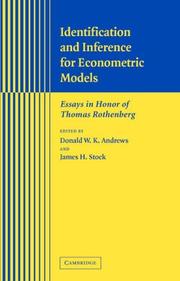| Listing 1 - 8 of 8 |
Sort by
|
Book
Year: 2005 Publisher: Cambridge, Mass. National Bureau of Economic Research
Abstract | Keywords | Export | Availability | Bookmark
 Loading...
Loading...Choose an application
- Reference Manager
- EndNote
- RefWorks (Direct export to RefWorks)
Book
Year: 2004 Publisher: Cambridge, Mass. National Bureau of Economic Research
Abstract | Keywords | Export | Availability | Bookmark
 Loading...
Loading...Choose an application
- Reference Manager
- EndNote
- RefWorks (Direct export to RefWorks)
Book
Year: 1989 Publisher: Cambridge, Mass. National Bureau of Economic Research
Abstract | Keywords | Export | Availability | Bookmark
 Loading...
Loading...Choose an application
- Reference Manager
- EndNote
- RefWorks (Direct export to RefWorks)

ISBN: 052184441X 9780521844413 9780511614491 9780521154741 0511115695 9780511115691 0511614497 1280162287 9781280162282 1107151937 0511122128 0511198523 0511299427 0511115148 052115474X Year: 2005 Publisher: Cambridge ; New York : Cambridge University Press,
Abstract | Keywords | Export | Availability | Bookmark
 Loading...
Loading...Choose an application
- Reference Manager
- EndNote
- RefWorks (Direct export to RefWorks)
This 2005 volume contains the papers presented in honor of the lifelong achievements of Thomas J. Rothenberg on the occasion of his retirement. The authors of the chapters include many of the leading econometricians of our day, and the chapters address topics of current research significance in econometric theory. The chapters cover four themes: identification and efficient estimation in econometrics, asymptotic approximations to the distributions of econometric estimators and tests, inference involving potentially nonstationary time series, such as processes that might have a unit autoregressive root, and nonparametric and semiparametric inference. Several of the chapters provide overviews and treatments of basic conceptual issues, while others advance our understanding of the properties of existing econometric procedures and/or propose others. Specific topics include identification in nonlinear models, inference with weak instruments, tests for nonstationary in time series and panel data, generalized empirical likelihood estimation, and the bootstrap.
330.115 --- Econometrie --- 330.115 Econometrie --- Econometric models --- Econometrics --- Mathematical models --- Econometric models. --- Modèles économétriques --- Business, Economy and Management --- Economics
Book
ISBN: 9786610162284 Year: 2005 Publisher: Cambridge Cambridge University
Abstract | Keywords | Export | Availability | Bookmark
 Loading...
Loading...Choose an application
- Reference Manager
- EndNote
- RefWorks (Direct export to RefWorks)
Book
Year: 2004 Publisher: Cambridge, Mass. National Bureau of Economic Research
Abstract | Keywords | Export | Availability | Bookmark
 Loading...
Loading...Choose an application
- Reference Manager
- EndNote
- RefWorks (Direct export to RefWorks)
This paper considers tests of the parameter on endogenous variables in an instrumental variables regression model. The focus is on determining tests that have certain optimal power properties. We start by considering a model with normally distributed errors and known error covariance matrix. We consider tests that are similar and satisfy a natural rotational invariance condition. We determine tests that maximize weighted average power (WAP) for arbitrary weight functions among invariant similar tests. Such tests include point optimal (PO) invariant similar tests. The results yield the power envelope for invariant similar tests. This allows one to assess and compare the power properties of existing tests, such as the Anderson-Rubin, Lagrange multiplier (LM), and conditional likelihood ratio (CLR) tests, and new optimal WAP and PO invariant similar tests. We find that the CLR test is quite close to being uniformly most powerful invariant among a class of two-sided tests. A new unconditional test, P*, also is found to have this property. For one-sided alternatives, no test achieves the invariant power envelope, but a new test. the one-sided CLR test. is found to be fairly close. The finite sample results of the paper are extended to the case of unknown error covariance matrix and possibly non-normal errors via weak instrument asymptotics. Strong instrument asymptotic results also are provided because we seek tests that perform well under both weak and
Book
Year: 2005 Publisher: Cambridge, Mass. National Bureau of Economic Research
Abstract | Keywords | Export | Availability | Bookmark
 Loading...
Loading...Choose an application
- Reference Manager
- EndNote
- RefWorks (Direct export to RefWorks)
This paper reviews recent developments in methods for dealing with weak instruments (IVs) in IV regression models. The focus is more on tests and confidence intervals derived from tests than on estimators. The paper also presents new testing results under "many weak IV asymptotics," which are relevant when the number of IVs is large and the coefficients on the IVs are relatively small. Asymptotic power envelopes for invariant tests are established. Power comparisons of the conditional likelihood ratio (CLR), Anderson- Rubin, and Lagrange multiplier tests are made. Numerical results show that the CLR test is on the asymptotic power envelope. This holds no matter what the relative magnitude of the IV strength to the number of IVs.
Book
Year: 1989 Publisher: Cambridge, Mass. National Bureau of Economic Research
Abstract | Keywords | Export | Availability | Bookmark
 Loading...
Loading...Choose an application
- Reference Manager
- EndNote
- RefWorks (Direct export to RefWorks)
This paper considers the use of the polynomial distributed lag (PDL) technique when the lag length is estimated rather than fixed. We focus on the case where the degree of the polynomial is fixed, the polynomial is constrained to be zero at a certain lag length q, and q is estimated along with the other parameters. We extend the traditional PDL setup by allowing q to be real-valued rather than integer-valued, and we derive the asymptotic covariance matrix of all the parameter estimates, including the estimate of q. The paper also considers the estimation of distributed leads rather than lags, a case that can arise if expectations are assumed to be rational.
| Listing 1 - 8 of 8 |
Sort by
|

 Search
Search Feedback
Feedback About UniCat
About UniCat  Help
Help News
News